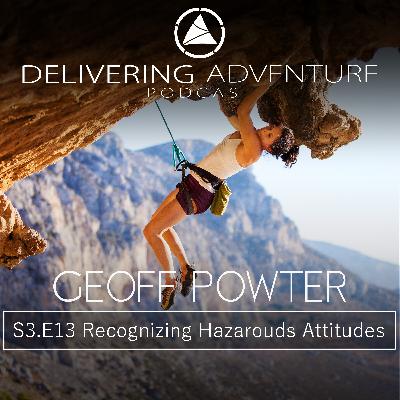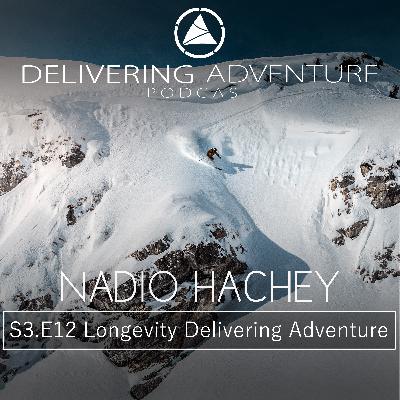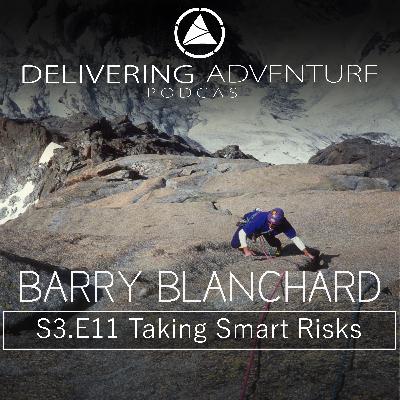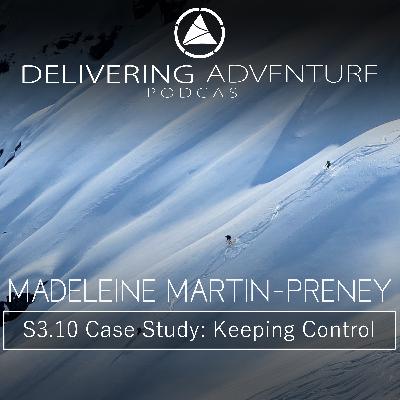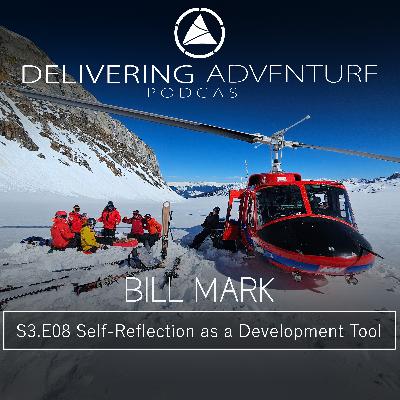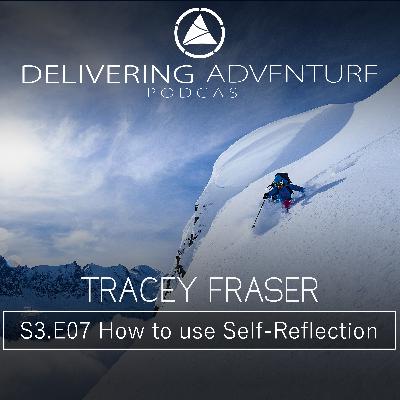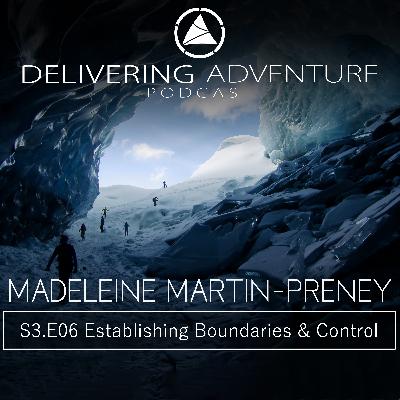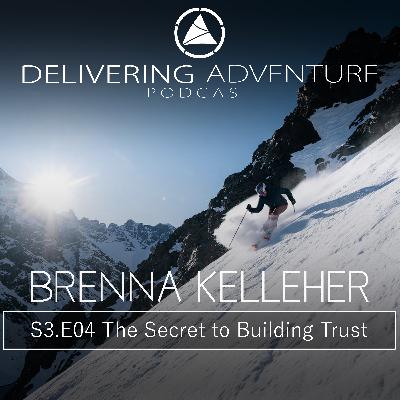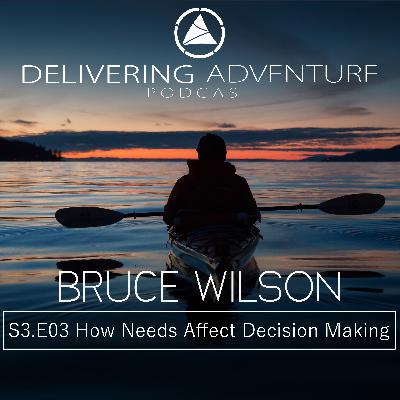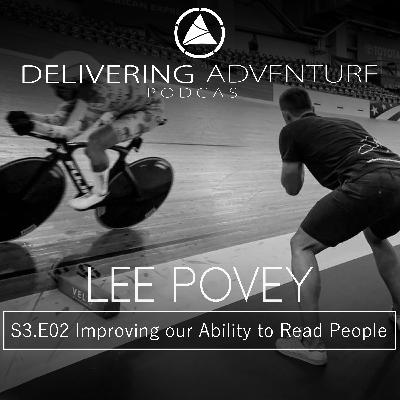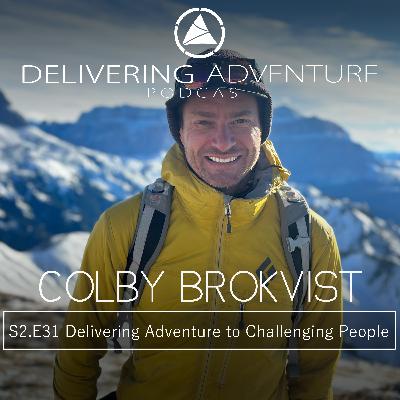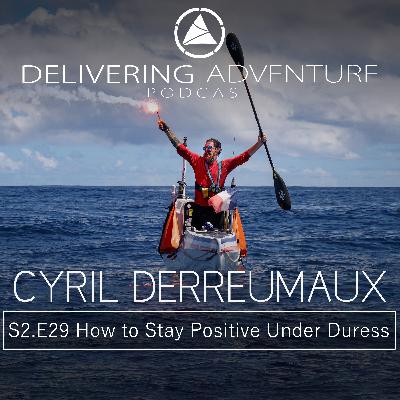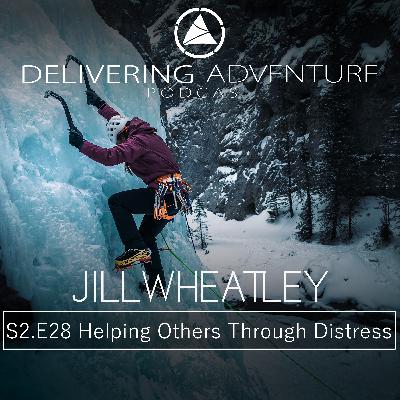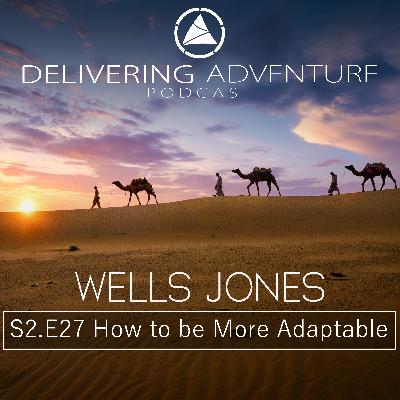Discover Delivering Adventure
Delivering Adventure

Delivering Adventure
Author: Chris Kaipio & Jordy Shepherd
Subscribed: 17Played: 451Subscribe
Share
© 2022 Delivering Adventure
Description
This is the podcast for people who want to share adventure like a pro – with their friends, family, or as a profession. Each episode explores a different aspect of adventure delivery with top experts to get their best stories, insights, and trade secrets. Learn what it takes to deliver epic experiences to yourself and others, from the mountains to the office, and beyond. Go farther, become better and achieve more. Chris Kaipio and Jordy Shepherd explore the essential skills and techniques that adventure industry experts use to delivery personal growth. Listen as adventure guides, managers, and promoters share their best advice on leadership, managing risk, coaching, and how to achieve experiences worth remembering. Topics include risk assessment, decision making, leadership, emergency response, crisis management, trip planning, memory building, marketing, capturing experiences, teaching new skills, improving performance, overcoming challenge, resiliency, communicating risk, and experience delivery. Whether you are leading people up the corporate ladder or to the tops of the world’s highest peaks, Delivering Adventure can help you to take yourself and others farther.Visit www.deliveringadventure.com to learn more.
71 Episodes
Reverse
How can our attitude affect our decision-making? The Federal Aviation Agency in the US has identified five specific attitudes that are present in airline accidents when human error is the cause of the crash or mishap. They have labeled these attitudes, the five hazardous attitudes.These attitudes are anti-authority, invulnerability, impulsivity, macho, and resignation. Each of these attitudes can negatively impact our judgement on a sub-conscious level, meaning we may not be aware of their presence.In this episode of Delivering Adventure, Geoff Powter joins Chris and Jordy to discuss what the five hazardous attitudes are and how we can recognize them in ourselves and others.Geoff Powter is a retired psychologist, an experienced climber, writer, and adventurer from the Canadian Rockies. He served as editor of the Canadian Alpine Journal for 13 years and has won 9 National Magazine Awards.Geoff has authored several books, including Strange and Dangerous Dreams, which won the Jury Prize at the 2006 Banff Mountain Book Festival and was adapted into a radio series. His second most recent book, Inner Ranges, won the Climbing Literature Prize at the Banff Festival in 2019 and the National Outdoor Book Award in the USA. His most recent book Survival Is Not Assured: The Life of Climber Jim Donini, is the Winner of National Outdoor Book Award in the USA.In this episode, Geoff uses his deep knowledge of phycology and risk taking to help us to better understand the five hazardous attitudes. This is the first of two episodes focussing on how we can recognize and manage these specific human factors.This is another must listen to episode for anyone who wants to better understand decision making and risk taking.Key TakeawaysAnti-authority Attitude: This is the “don’t tell me what to do,” mindset.Recognizing this in ourselves requires us to really question whether our decisions are being made because of our ego and the need to push back on being told what to do. Or is our judgment being influenced by reasoned self-confidence?Impulsivity Attitude: This is the “do it quickly,” mindset. We can spot this by looking to see if we are skipping steps that we either would normally do or know we should be doing. Also, asking ourselves if we do really need to rush and involving others in discussions can be very beneficial in spotting this in ourselves.Impulsivity is the one attitude that can cause us to move into situations faster which can push us into the hazard zone more quickly.Invulnerability Attitude: This is the “It won’t happen to me,” mindset. Invulnerability affects our ability to objectively assess the probability and consequence of taking risks.Spotting invulnerability requires us to be very aware of whether we really believe that a bad outcome can happen to us.Macho Attitude: This is the “I can do it,” mentality. The challenge with Macho is that it can cause us to become overconfident. As Geoff pointed out, there is also no macha attitude meaning that the macho attitude is more of a male dominated attitude.Resignation Attitude: This is the “what’s the use,” mentality. This is the attitude that can cause us to believe that there is nothing that we can do to prevent bad outcomes. This can leave us feeling resigned to fate. This can cause people to go along with what the group says, even if a person feels the group may be wrong.Resignation attitude can happen when we don’t care or we don’t trust our judgment. It can also happen when we feel helpless or we are not being heard.Guest BioGeoff is a retired psychologist, an experienced climber, writer, and adventurer from the Canadian Rockies. He served as editor of the Canadian Alpine Journal for 13 years and has won 9 National Magazine Awards.Geoff has authored several books, including Strange
Longevity Delivering Adventure with Nadio HacheyWhat does it take to enjoy a long career as an adventure guide, instructor or manager?The reality is that there is quite a high rate of attrition in the adventure industry when it comes to guides and instructors. It can be costly to get certifications and experience in both time and money. It can be physically demanding. It can also be far from financially lucrative. For all of these reasons many people drop out early in their career.That said, there are many people who have enjoyed long careers. One of these people is Nadio Hachey. Nadio has enjoyed a career in the ski and bike instruction and guiding industry that spans over forty years. Nadio supervises and trains ski and bike instructors at a high level and teaches at that level himself.Nadio joins Jordy and Chris to discuss what it takes to make delivering adventure into a sustainable career. He shares his insights on everything from decision making on the mountain to making smart choices with your finances.Nadio Hachey is a longtime manager in the Whistler Blackcomb Snow and Bike School. He is a PSIC level 4 certified ski instructor and a Level 4 PSIC LPT Trainer. He is also a certified level 2 PMBIA mountain bike instructor.This is an engaging and candid discussion about some topics that often go unspoken about.Key TakeawaysMaster Your Trade: If you want to have a long career on a professional, or even amateur level, you need to master the necessary hard skills. This includes things like navigation, skiing, snowboarding, biking or whatever it is - you have to be good at what you are actually doing. This keeps you safer and quite frankly, the people you may want to lead, expect you to be good at what you are leading.Decision making: It doesn’t matter how good you are at the hard skills of your activity. If you can’t make good decisions leading yourself and others, you won’t enjoy a long career. It’s that simple. People expect adventure guides, instructors and coaches to be able to make good decisions. Motivated to Help People: It doesn’t matter if you are in Search and Rescue, heli-skiing, surfing, biking, hiking, ski and snowboard instructing or a guide trainer. If you want to have a long career, you have to want to help people. Just wanting to do your sport or activity is not going to be enough for you. The people you are going to be dealing with are also going to figure out very quickly if you are there for them or yourself.Financial Needs: To sustain a long career in the adventure industry you need to be able to make enough and save enough to survive over the long term. This may mean picking up extra jobs, learning to cook so you can spend less going out, and being smarter with your money.Guest BioNadio Hachey has enjoyed a career in the ski and bike instruction and guiding industry that spans over forty years. Nadio supervises and trains ski and bike instructors at a high level and teaches at that level himself. This makes him a great person to share with us the secrets of what it takes to have a long career in the adventure industry.Nadio Hachey is a longtime manager in the Whistler Blackcomb Snow and Bike School. He is a PSIC level 4 certified ski instructor and a Level 4 PSIC LPT Trainer. He is also a certified level 2 PMBIA mountain bike instructor.Follow or SubscribeDon’t forget to follow the show!Share & Social Linkshttps://linktr.ee/deliveringadventure
Smart Risk Taking with Barry BlanchardHow can you know when to actually take a risk on a personal or professional level? What would a good risk, or a smart risk look like before and after?In this episode Chris and Jordy are joined by world renowned Alpinist, ACMG / IFMGA Mountain Guide, speaker, author and friend of the show, Barry Blanchard to discuss what a Smart Risk looks like.Barry Blanchard taps into his long career of risk taking and guiding to share the essential elements of what good risks look like, and what we should be wary of.Barry is a recent recipient of the Order of Canada and is an honoured member of the Association of Canadian Mountain Guides. He is respected for his ability to complete technical, high-risk ascents on a personal level and leading others as professional guide.Barry has worked on numerous movie projects as a stuntman including Cliffhanger and Vertical Limit. He is the star of his own documentary called Spindrift: The Barry Blanchard Story.He is also the author of The Calling: A Life Rocked by Mountains. Barry has another book coming out in 2026 called The Echo.Always engaging, thoughtful and honest, Barry shares some dark moments he has had in his career and many of the highlights. Along the way we define what makes a Smart Risk to take.Key Takeaways:Smart Risks: Are calculated, acceptable, necessary and prepared for. They are risks we can justify in the moment and after the fact because they are carefully considered, acceptable, needed to be taken and we were ready for the choice that we made.Calculated Risk: Calculated risks are ones that are well analyzed weighing the potential consequences against the potential for both positive and negative outcomes. The hazards are known and if you decide to take it, the benefits outweigh the potential costs.A calculated risk is a risk worth doing based on careful analysis.Acceptable Risk: Acceptable risks are the ones we can justify to ourselves and others. They should fall within everyone’s risk tolerance. They should also prioritize your safety ahead of safety or providing service someone else. Acceptable risks for professionals fall within industry best practices.Acceptable risks fall within personal, professional and legal responsibilities and limits.Necessary Risks: Necessary risks are the ones that need to be taken. They add value to the experience and contribute to towards achieving the objective. They are also the best option for what needs to get done.A risk might be acceptable to take, but also unnecessary.Prepared for: These are the risks we are ready for because we have prepared and built in an adequate margin of error. Worst case scenarios have been considered and planned for.Not Taking the Risk: This is also a risk. Smart Risks are the ones we did take for the right reasons.Guest BioBarry Blanchard is an ACMG / IFMGA Mountain Guide, author, speaker, and sometimes movie stunt man. Barry has recently been the recipient of the Order of Canada and has just been recognized as an honoured member of the Association of Canadian Mountain Guides.Both of these awards have been given in recognition of his numerous complex and demanding ascents in the Rockies, the Alps and the Himalayas, some of which have not been repeated. For more than 40 years, Barry has been a guide, resource and mentor to countless mountain enthusiasts.Barry is one of North America’s top alpine climbers. He has spent his life pushing the standards of highly technical, high risk alpine climbing and ice climbing from the Himalayas to the Canadian Rockies. Barry is also renowned for his ability to guide complex, high risk alpine ascents.Some of the movies that Barry has been in or has worked on include...
When it comes to delivering adventure, the difference between control and chaos can be as little as one small mistake. A situation can seem to be under complete control one moment and the next it can be spiralling away.The worst-case scenario for leaders often starts with something small. It can be a trip, a fall, a moment of butter fingers, or some other unforeseeable fumble or mistake.In this episode, Madeleine Martin-Penney shares a situation where a small misstep from one of her guests put her and her group in a potentially tough bind. Madeleine walks us through what happened and how she reacted to keep control.Madeleine Martin‑Preney is a certified ACMG Ski Guide, Hiking Guide, and Apprentice Rock Guide based in Revelstoke, BC. Born and raised in Nelson, BC, she earned her full ski guide certification in 2018. An avid backcountry adventurer, she completed the first full ski traverse of the Selkirk Mountains (520 km, 43 000 m elevation) and participated in the Bugaboos‑to‑Rogers Pass expedition featured in the film Mind Over Mountain. Guest BioMadeleine Martin‑Preney is a certified ACMG Ski Guide, Hiking Guide, and Apprentice Rock Guide based in Revelstoke, BC. Born and raised in Nelson, BC, she earned her full ski guide certification in 2018. An avid backcountry adventurer, she completed the first full ski traverse of the Selkirk Mountains (520 km, 43 000 m elevation) and participated in the Bugaboos‑to‑Rogers Pass expedition featured in the film Mind Over Mountain. Madeleine has served on the ACMG Board of Directors with Chris and I for the past nine years. She is also involved with Mountain Muscox. Mountain Muskox is a community-based organization that provides peer support circles for individuals who have experienced loss or trauma in the mountains. Guest LinksMadeleine’s Instagram: @madoalpineGeary’s Guiding: https://gearysguiding.comMountain Muscox: https://www.mountainmuskox.comFollow or SubscribeDon’t forget to follow the show!Share & Social Linkshttps://linktr.ee/deliveringadventure
How can we improve the decision making in others? When we are delivering adventure to others, it isn’t just the leader that needs to have good judgment. In every activity, there is a degree of decision-making skills that participants are going to need to be able to have, and if they don’t, the odds of achieving a good outcome start to go down.There is of course another dimension to this in that many guides and instructors aren’t just leading guests, friends or family. They may also be supervising or working with other guides or instructors.In this episode, we are joined by master guide, instructor, outdoor educator and friend of the show Bruce Wilson. Bruce returns to Delivering Adventure to explore how we can help others to improve their decision-making skills.When it comes to outdoor education and leadership training, Bruce is literally a Jack of all trades. Bruce is an ACMG Hiking Guide. He is a sea kayak guide and guide trainer for the Association of Sea Kayak Guides. He is an avalanche educator for Avalanche Canada.Bruce is a certified instructor in the Wim Hof Method, he has a master’s degree in leadership, and is a Vision Quest instructor, just to name a few of his many qualifications and certifications.He currently instructs the Outdoor Recreation Management Program at Capilano University in North Vancouver. He also provides coaching and guiding through his company Warrior Wolf Guide Services and Coaching.In this episode of Delivering Adventure, Bruce shares key strategies that leaders can use to help others to improves their decision making.Key takeawaysHow can we help others to make better decisions?Trust Them: Whether we like it or not, we have to trust the decision making and judgement of others. Micromanaging everything is not a sustainable option for anyone in a leadership position, and it can be argued that that isn’t even leadership!Create Opportunities: We need to give people the opportunity to make decisions. Decision-making is a skill. To develop skills, people need time on task to practice.Right Process: Teaching them the right process can help to set them up for success. Part of this requires us to model and then explain what a good decision-making process is.Go to Completion: It is important to let people bring their decisions to completion: this allows them to see and experience the consequences firsthand. This increases learning.Take it Seriously: Treat every moment as if it is real. This can eliminate the risk of developing bad habits. It also maximizes the learning.Guest BioWhen it comes to outdoor education and leadership training, Bruce is literally a Jack of all trades. Bruce is an ACMG Hiking Guide. He is a sea kayak guide and guide trainer for the Association of Sea Kayak Guides. He is an avalanche educator for Avalanche Canada.Bruce is a certified instructor in the Wim Hof Method, he has a master’s degree in leadership, and is a Vision Quest instructor, just to name a few of his many qualifications and certifications.He currently instructs the Outdoor Recreation Management Program at Capilano University in North Vancouver. He also provides coaching and guiding through his company Warrior Wolf Guide Services and Coaching.Guest Linkshttps://www.snowolf.caFollow or SubscribeDon’t forget to follow the show!Share & Social Linkshttps://linktr.ee/deliveringadventure
How can leaders use self-reflection as a development tool with others? Self-reflection is one of the most effective learning and development tools that a leader can use with themselves and their team members.Self-reflection can help everyone to learn from any mistakes that were made, flaws in systems that were uses, and to analyze actions that were taken.When guides and instructors use reflection with their guests, they create an opportunity to become aware of and to address problems. It also creates an opportunity to highlight learning opportunities and to ensure that everyone leaves with an accurate memory of events.In this episode of Delivering Adventure, Bill Mark joins Jordy and Chris to explore how leaders can use self-reflection with others.Bill Mark is a CSGA Certified Ski Guide and Guide Trainer. He has spent over Forty years in the ski industry working in ski patrol and as a guide. Bill’s current role is the Assistant Director of Ski Operations and Senior Lead Heli-Ski Guide for Mike Wiegle’s Heli-Skiing.Bill has extensive experience working with large teams of guides in high-risk environments where self-reflection is an essential tool for learning and development.Bill shares how leaders can use self-reflection with themselves and others effectively to improve sharing and leverage learning.Key TakeawaysUsing self-reflection as a leader effectively requires:Developing a Culture of Self-Reflection: Self-reflection is an essential component of developing a responsible risk-taking culture within teams. It is also one trait that can separate amateurs from true professionals. To leverage self-reflection, teams need to create a culture where self-reflection is encouraged and the time for it is set aside. This means scheduling it into the day and finding ways to make it a sustainable habit.Create Phycological Safety: Self-reflection only works if people are forthcoming and truthful with events, actions and thinking. To create an environment of open and honest communication, team members need to feel safe. To accomplish this, people should be rewarded for sharing mistakes instead of being punished or shamed. This is an essential component of creating psychological safety within the group.Look for Trends and Patterns: Humans are creatures of habit. When using self-reflection with others, leaders should be actively looking for unhealthy patterns or weakness in systems regardless of the outcomes. Correcting negative patterns, biases in decision making or poorly constructed or executed processes early, is an essential part of preventing future mishaps.Mentorship and Training (up for success): Leaders may need to train mentors and trainers how to use self-reflection effectively. It is a mistake to think that people in leader positions know how to use self-reflection effectively. Leaders may also have to train team members on how they can be mentored more effectively. This includes coaching them how to ask the right questions, how to learn from feedback and where to access mentorship.Guet BioBill started his career in the adventure industry working as a ski patroller in New Zealand before moving to Whistler for what was meant to be a season. Bill joined the Blackcomb Ski Patrol in 1987. He liked it so much he started doing back-to-back winters shuttling between the Whistler and working ski patrol in Cardrona in New Zealand, where he went on to become the ski patrol director.In 1991 he joined Mike Weigle’s Heli Skiing as a ski guide. Bill is now the Assistant Director of Ski Operations and Senior Lead Heli-Ski Guide for Mike Wiegle’s Heli-Skiing.Bill is CSGA L3 certified and has ISIA full certification (from NZ). He also instructs on CSGA courses and on CAA Industry Training Programs.When it comes to using self-reflection as a skill development
How can we use self-reflection to improve our decision making, performance and experience delivery?One of the best ways to undertake personal growth as an individual, a risk-taker and leader is to build self-reflection into our day.Self-reflection can help us to improve our performance, decision making, our delivery of information, and our relationships. While experience can be an essential tool for a guide, instructor and coach to have, experience itself is only good if we learn from it.In this episode, Jordy and Chris are joined by Tracey Fraser to discuss how we can harness the power of self-reflection more effectively.Tracey Fraser is the training manager at the Whistler Blackcomb Snow School. She is a certified CSIA Level 4 and PSIC Level 4 ski instructor. She is also a PSIC Level 4 LPT trainer which means that Tracey is certified to train ski instructors at the very highest level.Tracey shares how we can build self-reflection seamlessly into our day, how we can use it and what it can teach us.Key TakeawaysHow can we use self-reflection on a personal level effectivelyAdopt a Growth Mindset: This means approaching situations from the perspective that you want to know how to make them even better in the future, regardless of how well it did or did not go.Make Time to Reflect: This can include stepping away from others to think about what just happened, making time to ask other people for feedback or taking time at the end of the day to analyze high and low points.Be Curious with Yourself: This can include asking yourself if there is anything you would want to do differently, asking what went well, what were the challenge points, and what did not go well.Look for Patterns or Tendencies: We all have ways of doing things that could be problematic and may not be effective. These can include cognitive biases that can compromise our decision making. It can also include flaws in our systems and ways of doing things. Addressing negative patterns is an essential step to improvement.Embrace Being Vulnerable: It is okay to admit that there is room for you to do things better or to improve. Being vulnerable is not a weakness, it is a strength that you hear in most of our guests.Be Objective: To do this we have to focus on the facts by being non-judgemental. This includes avoiding the trap of rationalizing our actions to the point that we miss the opportunity to spot weaknesses in what we did.Guest BioTracey Fraser is the training manager at the Whistler Blackcomb Snow School which is one of the largest Snow Schools in the world with close to fifteen hundred staff. She is also involved with the Professional Ski Instructors of Canada and has worked with the Canadian Ski Instructors Alliance where she Chaired the CSIA Women in Skiing Committee.Tracey has represented Canada at Interski twice. She is a certified CSIA Level 4 and PSIC Level 4 ski instructor. She is also a PSIC Level 4 LPT trainer which means that Tracey is certified to train ski instructors at the very highest level.Follow or SubscribeDon’t forget to follow the show!Share & Social Linkshttps://linktr.ee/deliveringadventure
How can you keep control over a group without creating conflict? This is something that even the most experienced leader can find challenging. When people trust their leader’s decision making and are content to follow the leader’s directions, being the leader of the group can be easy.However, most people are not willing to blindly follow their leader’s direction. An important human need is to retain a sense of control. This need for control can often be driven by our ego. It can also manifest itself as an anti-authority mindset where we can want to do things our own way. Joining us to explore key strategies that leaders can use to keep the right amount of control over their group is Madeleine Martin-Preney.Madeleine Martin‑Preney is a certified ACMG Ski Guide, Hiking Guide, and Apprentice Rock Guide based in Revelstoke, BC.Madeleine shares important insights from her guiding career on how she manages to both give and keep control when she is leading. Knowing how to give and take control is an essential skill for every adventure guide, instructor and team leader to master. In this episode, we discuss how you can do it more effectively.Key TakeawaysHow can a leader maintain the right amount of control over a group?Having too little control: Can lead to people making decisions for themselves. This can cause people to go in different directions. When the leader does not have control, it can also erode trust in the leader. Having too much control: Can cause people to push back. Having a measure of control is an important need and when we do not give people some sense of control for themselves, they can rebel. People want to feel that they are part of the experience instead of just feeling like they are being led or managed.Right Balance: Give people control where you can so that you can take it back when you need to.Building trust early: Can help the leader to avoid having people challenge their control.Creating systems: Having everyone understand how systems work and how they can contribute to the system or work within it can be a really powerful tool.Guest BioMadeleine Martin‑Preney is a certified ACMG Ski Guide, Hiking Guide, and Apprentice Rock Guide based in Revelstoke, BC. Born and raised in Nelson, BC, she earned her full ski guide certification in 2018. An avid backcountry adventurer, she completed the first full ski traverse of the Selkirk Mountains (520 km, 43 000 m elevation) and participated in the Bugaboos‑to‑Rogers Pass expedition featured in the film Mind Over Mountain. Madeleine has served on the ACMG Board of Directors with Chris and I for the past nine years. She is also involved with Mountain Muscox. Mountain Muskox is a community-based organization that provides peer support circles for individuals who have experienced loss or trauma in the mountains. Guest LinksMadeleine’s Instagram: @madoalpineGeary’s Guiding: https://gearysguiding.comMountain Muscox: https://www.mountainmuskox.comFollow or SubscribeDon’t forget to follow the show!Share & Social Linkshttps://linktr.ee/deliveringadventure
What stops us from practising good self-care even when we know we should? What can we do about it? We all know that practicing good self-care is important. Unfortunately, it isn’t always easy.In this episode of Delivering Adventure, Sarah Janin returns to share a story of a time where she inadvertently neglected her self-care which led to some fairly serious consequences. This leads into a great discussion around some of the obstacles around practicing good self-care for us and the people that we may be leading.Sarah is a certified American Mountain Guide Association (AMGA) Rock and Split Board Guide and an assistant AMGA Alpine Guide. Sarah is on the final leg of working towards becoming the first IFMGA certified Mountain Guide who has type 1 diabetes. Based in Boulder Colorado, Sarah currently works as a full-time guide and one of the head guides at the Colorado Mountain School.Sarah joined Delivering Adventure in Season 2 to share her perspective on the importance of self-care. As a type 1 diabetic who leads an extremely athletic lifestyle, Sarah has a unique perspective on the importance and challenges of self-care.Always candid, Sarah shares her real-life challenges and learnings. This is a fantastic conversation.Key InsightsWhat are some of the obstacles to practicing good self-care and how can we avoid them:Common Self-Care Obstacles: Cost, pressure to prioritize service to others ahead of safety to us, and embarrassment as we may be holding others up.Macho Attitude: This is where we or the people we are leading may believe we can handle the consequences of not looking after ourselvesRecognizing Experience as an Obstacle: If we are inexperienced or younger, we may may not appreciate the long-term effects of not practicing good self-care.Projection Bias: This is where it becomes difficult to predict how we might feel based on how we are feeling in the moment. This can also be a reason why we do not prioritize self-care.Prioritizing Self-Care: Recognizing that self-care needs to be a necessary part of our day that needs to be prioritized. This is really step one. Being disciplined and holding ourselves accountable can help with this.Importance of Routine: Following a routine can be extremely beneficial – of note is that one danger sign of neglecting our self-care is when we break from our routine.Guest BioSarah Janin is a full-time mountain guide at Colorado Mountain School located in Boulder Colorado. She is the only full-time female guide at this time and one of their head guides. Sarah became one of the first certified female splitboard guides in America this March of 2024 making history.Sarah is on the AMGA track with one more exam to complete this summer. Her goal is to become the 19th certified female American Mountain Guide. Sarah will then have to pass a ski movement test in order to become IFMGA certified which will be her focus this winter.Sarah has worked as a guide for a decade after getting to experience a few different careers before settling on her true passion. Sarah is also a type 1 insulin dependent diabetic and has been for over 43 years. She will potentially become the first diabetic certified guide this year.Guest LinksColorado Mountain School: https://coloradomountainschool.com/guide/sarah-janin/Follow or SubscribeDon’t forget to follow the show!Share & Social Linkshttps://linktr.ee/deliveringadventure
How do you build trust? The ability to build trust is an important skill for anyone who wants to build and maintain relationships. It is also essential tool for a coach, instructor and guide to have if they want to help the people they are leading to achieve adventure.When people do not trust their leader, they are more likely to challenge decisions, question intentions and second guess direction. People are also far less likely to believe in themselves if they do not believe in their leader.In this episode of Delivering Adventure, Brenna Kelleher returns to share some of the secrets to building trust. Brenna has developed a successful career as an outdoor athlete, instructor, guide and realtor. She has been an NCAA ski racer for Montana State University and claimed the 2001 Junior World Championship as a freestyle kayaker. She has guided horseback trips in Yellowstone Park and has coached freestyle kayaking. She has also traveled to Africa leading a group of high school girls, as an educator in a semester abroad program; teaching math, travel journalism, and physical education in the distant outdoors.Brenna is a member of the Professional Ski Instructors of America’s National Alpine Team. In addition to being a PSIA Ski Instructor Examiner, Brenna is a ski instructor and guide at Big Sky Resort where she leads advanced women’s and youth-specific clinics.Brenna joined us back in Season 2 to explore how we can build more resilient teams. In this episode she shares what it really takes to build trust as a leader.Key TakeawaysBuilding trust requires us to:Develop rapport early: This can include finding points of connectivity by finding things everyone can relate to or has in common.Identify the Best Communication Style: Trust building involves determining how people are likely to respond to different communication styles. This also includes identifying their needs and aligning expectations.Be Right Early to Build Credibility: Being right early by delivering value can also help to build trust at the start of a relationship. One strategy that works well is to see if you can solve a problem that someone has early in your relationship.Maintaining trust requires us to: Deliver on promises, this can include showing up on time, meeting timelines and objectives.Be Flexible: Keep adjusting as situations often change. Keep checking in with the people you are leading to see where expectations, needs and your relationship with them stands.To avoid losing trust: Under promise where possible, be on time, own mistakes and respect people’s egos.About Them: If you can make people feel good about what they have accomplished and how they have accomplished it, they will feel better about you.Guest BioBrenna Kelleher has developed a highly successful career as an outdoor athlete, instructor, guide and realtor. She has been an NCAA ski racer for Montana State University and claimed the 2001 Junior World Championship as a freestyle kayaker. She has guided horseback trips in Yellowstone Park and has coached freestyle kayaking. Brenna has traveled to Africa leading a group of high school girls, as an educator in a semester abroad program. She is currently a member of the Professional Ski Instructors of America’s (PSIA) National Alpine Team.In addition to being a PSIA Examiner, Brenna is a ski instructor and guide at Big Sky Resort where she leads advanced women’s and youth-specific clinics.Guest LinksBrenna’s website: www.bigskybrenna.comInstagram: @brennakelleherFollow or SubscribeDon’t forget to follow the show!Share & Social Linksa...
How do our human needs affect our judgement? What happens fro our decision making if our needs are not being met?Using Maslow’s Hierarchy of Needs, Bruce Wilson joins Chris and Jordy to discuss the relationship between needs and judgment.Bruce Wilson is an ACMG Hiking Guide, a sea kayak guide and guide trainer for the Association of Sea Kayak Guides. He is an avalanche educator for the Canadian Avalanche Association.Bruce is a certified instructor in the Wim Hof Method, he has a master’s degree in leadership, and is a Vision Quest instructor, just to name a few of his many qualifications and certifications.Bruce currently instructs the Outdoor Recreation Management Program at Capilano University in North Vancouver. He also provides coaching and guiding through his company Warrior Wolf Guide Services and Coaching and teaches avalanche and survival courses for Canada West Mountain School.In this episode of Delivering Adventure, Bruce walks us through the intricacies of how needs affect judgment using real life stories and examples. This is a thoughtful and engaging conversation that ends with a look at how some First Nations peoples have prioritized human needs in relation to how we contribute within a community.Key TakeawaysHow do our needs affect our judgement?Needs Checklist: Maslow’s Hierarchy of Needs works like a checklist that we can use to help us to identify where people are at and what needs to happen to enable them to reach their full potential.Psychological and Physiological Needs: When these needs are not being met, our entire focus can become consumed trying to meet them. This can cause us to develop tunnel vision as we work to get warmer or more comfortable. Being low on energy or being dehydrated can also erode our ability to collect and analyze information accurately.Safety and Security Needs: Our risk tolerance can cause us to perceive the risk around us in ways that are not accurate. If we do not feel that we are in a physically or psychological safe space, we are more likely to ignore our other needs like feeling connected socially to a group.Communicating Risk to Others: It’s important to ensure that we are using language and framing information in a way that allows our audience to understand the risk accurately. This can help to improve their ability to make more informed choices.Love and Belonging Needs: People inherently want to feel that they are a part of the group. If they do not feel they belong to the group, they are more likely to make decisions that cause them to behave in a way where they are trying to increase their popularity. This can cause people to become manipulative or to undertake other attention seeking behaviours.Esteem Needs: If our esteem needs are not met, we are going to feel that we are not respected, and we may be less likely to trust others. When esteem needs are not met, we can start to develop self doubt. This can lead to us to second guess our choices. If our confidence is being eroded, it will directly undermine our competence.Self-Actualized Decision Making: This is when we can make reasoned and objective decisions by being open to the fact that we may not know everything. When we are self actualized, we are aware that we may not have all the answers and instead of having this undermine our confidence, it actually increases it.Guest BioWhen it comes to outdoor education and leadership training, Bruce is literally a Jack of all trades. Bruce is an ACMG Hiking Guide. He is a sea kayak guide and guide trainer for the Association of Sea Kayak Guides. He is an avalanche educator for the Canadian Avalanche Association.Bruce is a certified instructor in the Wim Hof Method, he has a master’s degree in leadership, and is a Vision Quest instructor, just to name a few of his many...
How can we improve our ability to read people? Being able to accurately interpret the people we are leading so that we can see things from their perspective helps us with decision making and problem solving. It can also help us to build trust and to recognize when their needs are not being met.In this episode, Lee Povey joins Chris and Jordy to discuss how we can al improve our emotional intelligence so that we can better empathize and understand others.Lee Povey is a high-performance leadership coach specializing in working with founders and start-ups. As a lifelong entrepreneur, a former elite cycling athlete, and Olympic Development Program Coach for USA Cycling, Lee has a deep understanding of what it takes to lead at the highest levels.Through coaching hundreds of World, National, and Olympic champions, Lee has gained invaluable experience in developing World-Class leadership and people. In this episode of Delivering Adventure, Lee shares practical advice and strategies developed through years of coaching high performance athletes.Key Takeaways:How can we improve our ability to read people:Lead With Curiosity: Often we want to make assumptions by guessing or anticipating the feelings or thoughts of others. Instead, we should be asking questions with an open mind as to what the answers might be.Ask the Right Questions: When we do ask questions, we need to make sure they are structured to reveal what we are looking to learn. Using a number system to identity how someone is feeling is one way. Another way is asking questions that are designed to generate discussion.Learn the Person: Everyone is different. Approaching each person as an individual and learning their tendencies, needs and how they react in certain situations can help us to recognize patterns of behaviour. This can allow us to interpret what they may be telling us more accurately.Training Them to Self-Analyze: When people can self reflect they can understand what is going on themselves.Check for Understanding: Often we give people instructions, explanations or feedback and assume they understand what we want them to take away or to do. What we really should be doing is to get them to tell us in their own words what they understood.Reading Body Language: This makes up a large part of how people communicate. Recognizing the behavioural patterns in the people we are interacting with can greatly enhance our ability to empathize and to interpret the thoughts, feelings and behaviours in others. Like every skill, improving our emotional intelligence so that we can better read others, takes purposeful practice.Guest Bio:Lee Povey is a high-performance leadership coach specializing in working with founders and start-ups. As a lifelong entrepreneur, a former elite cycling athlete, and Olympic Development Program Coach for USA Cycling, Lee has a deep understanding of what it takes to lead at the highest levels.Through coaching hundreds of World, National, and Olympic champions, Lee has gained invaluable experience in developing World-Class leadership and people. Lee helps leaders and high-achievers understand how to motivate, lead, give feedback, and empower their teams to incredible growth and performance. He breaks down the human experience in a relatable way, sharing tips, skill sets, and valuable mindset insights, allowing us all to perform like Olympians while retaining a strong focus on happiness and long-term fulfillment. Guest Links:Lee Povey: www.leepovey.comFollow or SubscribeDon’t forget to follow the show!Share & Social Linksa...
How do you become a great instructor? No instructor or guide wants to be mediocre. Few students or guests want their instructor to deliver an average performance. This would hardly improve learning, create great stories or build positive memories. So how can instructors, coaches and guides be great?One person who has worked extremely hard to become consistently great at instructing and guiding is Cyril Shokoples. Cyril is an ACMG / IFMGA Mountain Guide and a past president of the Association of Canadian Mountain Guides. Cyril is also an EMS instructor, and an Open Water Scuba Instructor. Cyril specializes in teaching high angle rope rescue, avalanche safety, avalanche search and rescue, wilderness emergency care and mountaineering skills.Cyril has been training Canadian Forces Search and Rescue Technicians, known as SAR Techs, for over thirty-five years. He was also responsible for the creation of the Parks Emergency Responder program for national park wardens in Canada.When he is not teaching, Cyril has been working extensively in the guiding industry as a climbing and Heli-ski guide.Cyril joins Chris and Jordy to share key strategies and philosophies that can help anyone to be become better at instructing and guiding. If you work hard, Cyril’s advice might even help you to become great!Key TakeawaysHow can we become great instructors and guides?Start by Aspiring to Great: If you want to be great, you have to want to be great in the first place. We generally become what we aspire to be. If your goal is to be merely average then that’s likely what you will end up delivering.Prepare Like a Professional: This can sometimes require us to spend longer getting ready for what we are going to be instructing or guiding, than it is actually going to take us. Preparation should involve anticipating anything that can happen like the questions that might be asked, or anything that could go wrong.Practice With Purpose: This can involve mixing up how we do things including trying out new ways of explaining or presenting information. It also involves reflecting on how we did after the fact with the goal being to learn how we could do it even better in the future. If we keep doing the same thing without reflecting on how we can make it great, we can expect to get results that are more likely to be mediocre.Ask People for Their Advice: Don’t underestimate the fact that people like to share what they know. This is a human need that most people have.When Presenting: Try to stay calm, be dynamic, engage the group you are dealing with and add fun where possible.Guest BioCyril Shokoples started his career as a scout leader over forty years ago. Since then, Cyril has become one of the most respected rescue skills instructors and mountain guides in Canada.Cyril is an ACMG / IFMGA Mountain Guide and a past president of the Association of Canadian Mountain Guides. Cyril is also an EMS instructor, and an Open Water Scuba Instructor. Cyril specializes in teaching high angle rope rescue, avalanche safety, avalanche search and rescue, wilderness emergency care and mountaineering skills.Cyril has been training Canadian Forces Search and Rescue Technicians, known as SAR Techs, for over thirty five years. He was also responsible for the creation of the Parks Emergency Responder program for national park wardens in Canada.When he is not teaching, Cyril has been working extensively in the guiding industry as a climbing and Heli-ski guide.Guest LinksCyril Shokoples: www.rescuedynamics.caFollow or SubscribeDon’t forget to follow the show!Share & Social Links
How do you deal with challenging people on an adventure? This is a challenge that can test even the most experienced and prepared leader.When it comes to delivering adventure, people can be grumpy. They can have unrealistic expectations. They can show up to an adventure with personal issues. They may not have the resiliency needed to manage or overcome challenges. Some people are socially awkward, while others are just rude. In some cases, people may have anger management issues. In other cases, they may not want to be there at all.While most of these situations are not a leader's fault, they often do end up becoming the leader’s problem.In this episode, we are joined again by master guide, guide trainer and author, Colby Brokvist. Colby joins us to explore some of the strategies that we can all use when we find ourselves dealing with challenging participants on the adventures we are leading.Colby Brokvist is a professional guide who leads worldwide expeditions for some of the most acclaimed companies in adventure travel. He has guided trips around the world including in Greenland, Antarctica, Africa, and Patagonia, as well as throughout the United States and Canada. Colby currently serves as the Chair of the Polar Tourism Guides Association.Using his expertise and extensive experience, Colby has written The Professional Guides Handbook – How to lead adventure travel trips and expeditions. This is a great resource for anyone leading others. Colby has also recently launched the Waypoint Guide Academy.Key TakeawaysHow we can better manage difficult people:Unmet Needs: If you can figure out what needs are not being met and meet them, you can unusually create a situation where they are easier to deal with.Aligning Expectations Early: This is essential. People tend to get what they expect, so ensuring expectations are known to everyone and are realistic can address a lot of problems before they arise.Pulling Difficult People in: Gives an opportunity for leaders to build relationships with them. It’s important to remember that people can usually tell when people other people don’t like them. If someone is being difficult and they don’t feel the leader is getting along with them, resolving the conflict becomes that much harder.Leading with Empathy, Patience and Curiosity: Can help leaders to build healthier relationships with the people they are leading. When people are being difficult it can be very valuable to try to discover why. This can take some empathy, and some detective work.Guest BioColby Brokvist is a professional guide who leads worldwide expeditions for some of the most acclaimed companies in adventure travel. He was inspired to pursue guiding as a career during a through-hike of the Appalachian Trail in the summer of 2000. Since then, he has led hundreds of adventure travel departures as an Expedition Leader, ranging from backpacking and trekking adventures to mountaineering and rock-climbing trips, sea kayaking and sailing voyages, and wildlife safaris. His work has taken him to destinations as far-flung as Greenland, Antarctica, Africa, and Patagonia, as well as throughout the United States and Canada. His current basecamp is Boulder, Colorado.When not actively leading trips in the field, Colby assumes a variety of managerial, operational, and consulting roles within the adventure travel sphere. His work centers on developing and facilitating guide training courses and programs as well as trip program consulting and field-based guide team management. Colby also serves on the board of directors for the Polar Tourism Guides Association and is a certified Senior Polar Guide through the same organization.Guest LinksThe Professional Guides Handbook – How to lead adventure travel trips and expeditions - a...
How can technology enhance our adventure experiences on skis? Is it possible that ski coaches, instructors and guides can be replaced by technology all together?In this episode we touch on these questions as we explore Carv with Morgan Engel and Alex Jackson. Carv is a small device that skiers can affix to their ski boots that analyzes their movement patterns as they ski. The data that Carv collects is uploaded to a user-friendly app on a Smart Phone. From here, users can either analyze the data and metrics themselves. Users can also select one of the coaching modes that provides targeted feedback. This makes Carv the largest ski school in the world by hours taught!Alex Jackson is the VP of Marketing for Carv and is based in the UK. Morgan Engel is a PSIC Level 4, CSIA Level 4 and PSIA Level 3 ski instructor and a PSIC Level 4 Licensed Professional Trainer in Whistler, British Columbia. Morgan has been working with Carv as an Ambassador and Advisor for the past six years. Morgan has also helped develop the Carv Instructor Certification offered through the Professional Ski Instructors of Canada.Morgan has been working with Carv as an Ambassador and Advisor for the past six years. Morgan has also helped develop the Carv Instructor Certification offered through the Professional Ski Instructors of Canada.Alex Jackson and Morgan Engel share their insights on what Carv is and how it can be used as a development tool for not just skiers, but by instructors, guides and coaches.TakeawaysInnovative: Carv is definitely a well thought out skill development tool for skiers that adds the possibility of gamifying skiing by trying to reach higher and higher scores. It is also nice to have a tool that measures your performance objectively with weight being placed on your performance instead of your style.Does Not Replace Snow Sports Professionals: There is still an important role for instructors when it comes to interpreting and communicating the data and structuring development. Carv also isn’t going to tell you where the best snow is on a given run or how to prepare for what you are going to encounter before you get there.Adventure Enhancer: Carv is an excellent example of where technology can enhance the user experience. Other technologies that I can think of are apps like Stava and Gaia and devices like GoPros and even Smart Phones.Importance of Milestones: To keep us motivated and in a positive space, we need be able to break progress into small pieces. The one thing that Carv does well that other similar technologies should take note of is pointing out each time the user has reached a new level. It might be improving a certain metric or achieving an improved score. Guest BioAlex Jackson is based in London, UK and is the co-founder and VP of Marketing for Carv. Alex has enjoyed a very successful career in technology. His passion is products that can change the way people behave.Morgan Engel is a PSIC Level 4, CSIA level 4 and PSIA Level 3 ski instructor who has over 35 years of teaching and instructor training experience. Morgan started his ski teaching career at Hidden Valley in Alberta. He is currently teaching at Whistler Blackcomb. In addition to teaching, Morgan is also PSIC Level 4 Licensed Professional Trainer.Morgan has been working with Carv for the past six years as a Carv ambassador and advisor. He has also used his experience with Carv to develop the Carv Instructor Certification for the PSIC. Guest LinksCarv Website: https://getcarv.com/Carv Pro Deal for Professionals: https://getcarv.com/lp/pro-deal-2024PSIC Carv Instructor...
How do you stay positive under duress? It doesn’t matter how adventurous, fit, risk tolerant or determined you are. At some point, you will find yourself in a situation where it becomes hard to stay positive or even to find the will to keep going. It could be as simple as sitting on a cold wet chairlift, riding your bike on a long climb that feels endless or out on a hike that seems to go on forever.Joining us in this episode to explore how we can effectively manage our mental state in the face of discomfort is Cyril Derreamaux. Cyril is a long-distance solo kayaker, adventurer and speaker.Cyril has just completed solo kayaking, unassisted across the Atlantic Ocean on his way from the Canary Islands to Martinique. This 3000-mile journey took Cyril 71 days, 14 hours and 57 minutes.Cyril has also paddled his custom-made kayak solo from California to Hawaii. This is a trip that took him 91 days which he completed in 2022.Cyril is a two-time World Record Holder who has several other long-distance trips under his belt including being part of a four-member rowing team that also paddled from California to Hawaii.Cyril is an epic speaker and is perhaps one of the most passionate guests we have had on our show and he offers some excellent advice!Key TakeawaysHow do you maintain a positive mindset in the face of adversity:Self-Awareness: If we want to coach ourselves, we need to be able to recognize when our discomfort is becoming an anchor that is dragging us down and what is needed to push us forward.Being the Self Critic: Requires us to ask ourselves if the pattern of behaviour that we have is good or bad. For example, is how we feel negatively impacting our performance and becoming a barrier to success?Getting a Third-party Opinion: This means asking others for their feedback. Sometimes we need to reach outside ourselves to get an objective assessment of how we are doing. This can involve asking our friends, colleagues or even feeling out our guests.Reframing: This involves confronting the situation in a way that helps us to change our perception from something that might be negative to something that is more positive. This can help us to adapt more effectively mentally.Adapt and Execute: Means putting all of this into action and moving forward. Once we recognize this, we can start to take steps to manage our mental and emotional state so that we can better cope with our situation and keep us going in the direction that we need to be headed.Guest BioFrench born, now American citizen, Cyril Derreumaux considers himself a citizen of the world. Fluent speaker of 6 languages (and counting!) Cyril is attracted to learning and discovering new cultures and places all the time.This natural curiosity of people and places led Cyril to backpack around the world at 25 for one year. With $7,000 and a can-do attitude Cyril embarked on this life changing experience that permanently changed his outlook on life and how he wanted to live it.A move to California following his profession in the wine business led Cyril to begin exploring the world of outrigger canoeing and kayaking and reignited a childhood passion for windsurfing and all things water related. He soon began pushing his limits further and further in ultra-endurance water events. A serendipitous find of the Great Pacific Race which advertised “you don’t need to be a rower to row an ocean” led Cyril to embark on his biggest challenge at the time, rowing in a team of 4 men from California to Hawaii which resulted in in a Guinness Record for the fastest ocean rowing crossing of a team in 39 days and again changing Cyril’s perspective on what was possible.Always a dreamer, Cyril soon found himself thinking about his next expedition. Inspired by the stories of maverick ocean explorers, Cyril began to...
How can we help others when they are experiencing distress? We have all been in situations with friends, family or clients who are experiencing distress due to adversity. These challenging moments can come when people have suffered an injury, illness, or are working through physical or mental discomfort.When we find ourselves in these situations, knowing what to say, what to avoid saying, or how to act can be difficult regardless of how well intentioned we are.In this episode we are joined again by Jill Wheatley who is going to walk us through some strategies that we can use to help people through distress and adversity.Jill Wheatley is no stranger to experiencing distress herself. Jill experienced a freak accident while on a teaching assignment that resulted in a traumatic brain injury. This resulted in her losing 70% of her vision as well as a life-threatening eating disorder.More recently, Jill’s resiliency has been tested once again when a fall ice climbing last winter led to multiple breaks in her leg and ankle.Jill reflects on the lessons learned on climbing expeditions in the Himalayas and recovering from injury on how we can help others when they are suffering.This is the second episode with Jill, and she continues to be candid and remarkable.Key TakeawaysHow can we help people through distress whether it be from injury, illness, discomfort or challenge:Be empathetic: This means putting yourself on their position and trying to see the situation through their eyesRecognizing Empathy Versus Sympathy: Empathy is understanding what someone might be going through while sympathy is feeling sorry or pitying them. Leading with empathy is a far more effective strategy to help people than sympathy.Listening can be a Very Powerful Tool: We can often want to try to solve people’s problems when simply listening to what people have to say would be far more beneficial. Sometimes people just want to share their pain, stress and discomfort and be heard.Acknowledge Reality: Acknowledging that people are suffering can also be beneficial. As Jill pointed out, when we are in a weakened state, we don’t necessarily want to hear that we are fragile, or under-performing. We also don’t want to hear that everything is fine.Everyone is Different: When it comes to dealing with people, there is really no one size fits all strategy.Guest BioFollowing a traumatic brain injury that resulted in life threatening complications and 70% vision loss which required 26 months spent between 7 different health care facilities in 3 countries, Canadian Jill Wheatley was dropped at Denver International Airport with no direction. The only sign she could see pointed to mountains. Despite such compromised eyesight, Jill chose to spend one year alone with Mother Nature in an attempt to find light on life’s trail. Her search led through 13 different massifs and upon running in the Annapurnas in Nepal, she knew that she wanted to spend more time among Himalayan giants. Essentially she has gone from being bedridden, to a wheelchair, then on to walking, navigating hospital parking lots to hiking, trail running, mountain running and skiing before climbing 5, 6, and then seven 8000 m peaks and spending the past 5 years based in Nepal. In a story made for movies, Jill’s trail has recently connected to another type of climb when she had a lead fall ice climbing in February 2024 not long after shifting home from the Himalayas to the comforts of Canmore in the Canadian Rockies. With multiple breaks in her leg and ankle, she is committed to a full recovery and getting back to breaking down the stigma associated with brain injury, vision loss and eating disorders while encouraging and helping others get out to do wild things in wild places. Guest...
An essential adventure and life skill is the ability to be adaptable. Being adaptable allows us to adjust to change and to keep our cool when we find ourselves in adverse or stressful situations.In 2005, Wells Jones set out to retrace the path of the famous soldier and adventurer TE Lawrence - also known as Lawrence of Arabia. The goal of this trip was to prepare for an acting role.On that trip, Wells and his friend Miles went through 39 border check points, trekked through the desert by camel and dared to go where few westerners were willing to travel in the wake of 9/11. All the while they had to vigilante to avoid being kidnapped.Wells and Miles have recently released a book that they wrote based on this trip called A Line in the Sand.In this episode, Wells shares his philosophy of adventure in a candid and at times deeply personal and intense way as well as key strategies that we can use to increase our adaptability.Key TakeawaysHow we can increase our adaptability:You are More Adaptable Than you Think: All of us are already adapting to many different situations that we may take for granted.Yes, I Can Mindset: When you are faced with a situation that pushes you outside your comfort and challenge zone, and you aren’t sure whether you can adapt, it can be really helpful to adopt a mindset where you say to yourself, yes I can do it. Focussing on success instead of failure, and believing in yourself can be the difference makers between adapting to new and challenging situations and potentially overcoming adversity - and giving in.Prepare to Relinquish Control: Adapting to new situations may require you to let go of control. Trying new things requires us to go against status quo bias where we may choose familiar patterns where we feel we have control. This can require us to have an open mind and simply embrace the adventure. Embrace change.Adopt an Adaptable Mindset: An adaptable mindset is one where we embrace even the difficult moments in a way that allows us to find value. Happy people find value in every moment, while unhappy people tend to go looking for problems. To adapt, we need to look for value.Guest BioWells Jones started his career as a US Navy Antarctic Pararescue Team Member. This included precision skydiving, technical training mountain/glacier/crevasse rescue, Antarctic survival, advanced to instructor.Wells went on to graduate from the American Academy of Dramatic Arts in New York. He has since worked in plays, commercials, TV series and films. His acting name is Tad Jones.In addition to acting, Wells has also worked as a producer and director.In 2005, Wells and his friend Miles Spencer set out to retrace the steps of TE Lawrence through the Middle East. The goal of this trip was to prepare Wells for an acting role.On that trip, Wells and his friend Miles went through 39 border check points, trekked through the desert by camel and dared to go where few westerners were willing to travel in the wake of 9/11. All the while they had to vigilante to avoid being kidnapped.Wells and Miles have recently released a book that they wrote based on this trip called A Line in the Sand. A Line in the Sand is an excellent read and can be found on Amazon.Guest LinksA Line in the Sand: Available at Amazon HereFollow or SubscribeDon’t forget to follow the show!Share & Social Linkshttps://linktr.ee/deliveringadventurea...
When it comes to adventure sports, one of the best ways to manage risk is to ensure that you are as physically durable as possible. Being physically durable allows you to withstand physical challenges, mistakes and mishaps like falls. In this episode, we are joined by Dr. Leslie Desrosiers. Dr. Leslie is the founder of ACL Strong. ACL Strong is a comprehensive online strength training and exercise program. While the focus of ACL Strong is on preventing knee injuries through targeted exercises and stretching, it encompasses a full body approach.Dr. Leslie shares some of the keys to improving our physical durability from warming up properly to being more efficient with our training. Increasing our physical durability doesn’t have to take long. Dr. Leslie tells us how we can work smarter, not harder!Key Takeaways:Diversify Training: This includes neuromuscular training, cardio, stretching and strengthening. Strengthening includes weight training to build your muscle mass. Cross training and using training programs will help to prevent injuries and enhance performance. Time Commitment: It doesn’t have to take long if you are efficient. Using the right exercises and stretches and doing things correctly can save you time.Whole Body: Because your entire body works together, you need to work on your whole body to improve durability. Many outdoor activities focus on specific muscle groups, while training programs offer a wider benefit.Insurance Policy: Increasing your durability is like an insurance policy that will reduce your chance of injury and will increase your chances of enjoyment.Avoiding Flare ups: If you feel stiff or things don’t feel right, address it early. This can help to reduce the chance of an overuse injury. It is easy to ignore inflammation or discomfort and try to work through it, but this isn’t a very good long-term approach.Aging Bodies: The older we get, the more important all of this becomes.Guest Bio:Dr. Leslie Desrosiers, PT, DPT, OCS, CSCS is a Doctor of Physical Therapy and Orthopedic Specialist, currently residing and operating a private physical therapy practice in San Marcos, CA. As an injury prevention specialist, Dr. Leslie and her team developed ACL Strong, an ACL injury prevention program, helping athletes and active people protect their knees and prevent major ligament injuries so they can excel in sports and add years to their career. She is a mom of two, enjoys an active lifestyle, and loves helping people with her knowledge and expertise.Guest Links:ACL Strong: www.aclstrong.comACL Strong Membership: https://training.aclstrong.com/membership-pricingFollow or SubscribeDon’t forget to follow the show!Share & Social Linkshttps://linktr.ee/deliveringadventurehttps://deliveringadventure.com
How to Prepare for Big Adventures with Cyril DerreumauxWhat does it take to prepare for a really big adventure? One of the main reasons people get themselves into trouble and have a misadventure is a lack of preparation. You can have all the skills in the world, the best equipment and the best intentions, but if you aren’t prepared, you may quickly find that what you thought was a perfect plan has a gaping hole in it.Joining us is Cyril Derreumaux. Cyril is a long-distance solo kayaker, adventurer and speaker. Cyril is a two-time World Record holder. He has paddled his specially built kayak unassisted from California to Hawaii. This trip took him two attempts and 91 days to complete. Using that experience, Cyril is about to embark on another trip in a bid to cross the Atlantic. He hopes this trip will take him from the Canary Islands to Martinique. This is a distance of 4800 kilometres.Cyril shares with us how he prepares for his epic trips operationally, logistically, physically, and emotionally. We look at how we can apply the lessons learned preparing for big expeditions to adventures of any length.Key TakeawaysHow to prepare for big adventures:The Key to Success is Preparation: Cyril was extremely prepared. He spends more time preparing than the length of the actual trip. If you want to ensure you succeed you need to be prepared to put on the time and energy beforehand.All in Approach Beforehand: Small trips provide practice for longer more challenging excursions. Practicing skills, taking courses, and preparing for emergencies are all important steps that contribute towards success.Family Members: It is important to remember that family members share the risk when people are on adventures. There are often sacrifices and compromises made by both the adventurer (or person delivering adventure) and their families.On the Adventure: It is important to maintain rhythm and routine as much as possible. On some trips it is easy to have routine during an approach. But then when we are on the route or in more difficult or hazardous parts of the trip, we need to break the routine and move quickly. But we must still remain vigilant and make good decisions. As Cyril said, an injury can easily result in rescue and mark the end of the adventure.Reflect and Learn: Most adventurers and those delivering adventure strive to become consciously competent, as Cyril has done. This requires us to reflect on our experiences in a way that allows us to learn and develop. As Mark Twain said: "Good judgement is the result of experience and experience the result of bad judgement."Follow or SubscribeDon’t forget to follow the show!Share & Social Linkshttps://linktr.ee/deliveringadventurehttps://deliveringadventure.comCover Photo by Tom Gores


